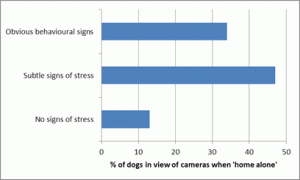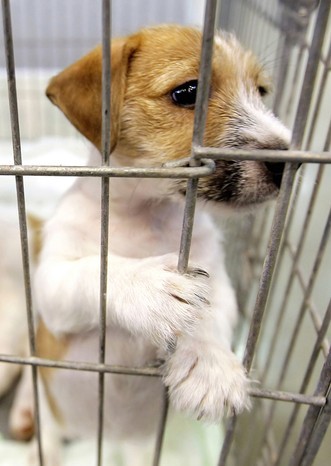Category: Separation Related Behaviours
How puppies become anxious ‘home alone’ dogs
With the recent Channel 4 documentary ‘Dogs: Their Secret Lives’1 in the UK raising awareness of the welfare issues of ‘home alone’ dogs and separation related behaviours (SRBs), I am sticking with this theme for my next blog. Identifying and appropriately treating affected dogs with validated and tailored treatment programmes is important2,3,4; but considering the extent of this worrying welfare problem, prevention is paramount.
Giving puppies the right experiences of being left alone from the start goes a long way to preventing separation related behaviours (SRBs) or separation anxiety later in life. As is so often the case when considering the prevention of problem behaviours, putting in time and thought during the early life of a puppy is beneficial in the long-term.
Research suggests that puppies show behavioural responses to separation from 3 weeks of age5, and increased cortisol (a physiological indicator of the stress response) on separation from 5 weeks6. The process of getting puppies used to short periods of separation should therefore start with the breeder. Initially puppies need to be picked up and just momentarily held away from littermates. The gradual process of habituation to being alone should then continue when puppies go to their new homes, and there are various resources describing how to go about this1,7,8,10. The aim of this blog is to illustrate why following these guidelines is so important for the long-term welfare of dogs.
Taking a “dog’s point of view” of being left alone is perhaps the best way to consider this. I would like to use the example of ‘Frodo’ a Jack Russell terrier, and I invite you to imagine him arriving for the first time in his new home at 10 weeks of age. He has just been picked up from the breeder’s house and brought home to his new family. He has settled in pretty well considering the complete change in his world, and has started to learn about his new social group – the members of the Mitchell family. He has been with the family all afternoon and enjoyed all the attention, but now it is bedtime, and Frodo is settled into an indoor kennel in the kitchen and left alone. This is the first time he has ever been all alone, having always been with littermates or mum before. He is worried, and reacts by scrabbling about at the door of his kennel and crying loudly. Mr Mitchell hears his cries and comes back to settle him down again. Frodo settles down when he has company, but when Mr Mitchell heads off to bed again, he starts to cry straight away, bringing his owner back to the kitchen.
In this first scenario, Frodo finds being alone new and scary, but also learns that crying is an effective ‘strategy’ to resolve his anxiety – because it is successful at regaining social contact. He has not learnt to be OK on his own, but has learnt an active response to address this incredibly scary problem that works for him. As time moves on in this example, Mr Mitchell may get fed up of coming down and reassuring his new puppy, and stay in bed with ear plugs in. Because crying has always worked before, Frodo may carry on crying for a long time, and maybe also start howling. He will become more and more anxious, waiting for someone to come. Eventually Mrs Mitchell might wake up and come to settle him down. So Frodo learns that even if he has to cry for a long time, it will eventually work – in other words it is worth persisting with crying even if it doesn’t work immediately. Frodo is already well on the way to developing an active SRB. He may go through life always being anxious about being left alone, persistently crying and howling in an attempt to resolve his distress – because he has learnt that, at least sometimes, this will work to get back with his social group.
Imagine now, in a parallel universe (scenario 2), that he managed to get the door of his indoor kennel to ping open by scrabbling at it on that first occasion he was left alone, enabling him to run into another room to find his human family. Because scrabbling worked to resolve his situation, he would be more likely to scrabble at the door the next time he was put in the kennel – and if the door fixing was still dodgy, he might get out again. In this scenario, Frodo might develop an active destructive response to being left alone which persists throughout life.
Because these behaviours – howling and destruction – are a ‘problem’ for owners, advice in the past has commonly been to make sure that the first signs of such responses are not reinforced. Prevention advice used to focus on not ‘giving in’ to crying or scrabbling, but leaving the puppy alone to make sure that these responses were not rewarded by owner return. This approach meant that these behaviours would not become ‘successful’ and less likely to become SRBs. That is true, but there is a considerable problem with this approach. Behavioural signs may not be so obvious, but nothing has been done to stop the puppy being anxious about being left alone.
Now imagine Frodo in his kennel in yet another parallel universe (scenario 3). This time his owners have heard that they should completely ignore any responses to being left alone. The family go off and leave Frodo in his kennel, they all put in earplugs and go off to sleep. He is terrified, trapped in his kennel. He cries and cries, and scrabbles and scrabbles, but nobody comes. He tries again, crying and scrabbling. He gets so anxious that he toilets in his bed. He gets exhausted after a time, and gives up trying to get out or to get attention – finding that whatever he does there is no way of controlling his situation or resolving the cause of his anxiety. He goes quiet, terrified and shivering in his wet bed and waits…and waits… (better stop there, before I make myself cry!)
In this scenario, no problem behaviours are reinforced, but Frodo is still very anxious about being left – possibly more so as he has no active strategy that he can try to have some control over his environment. Although Frodo may not have an obvious ‘problem’ SRB as he grows up, he is very likely to still be anxious when left alone – and may remain so for life. He is likely to end up as one of the dogs which show more subtle signs of anxiety and perhaps physiological signs of stress (termed the ‘inactive anxious’ group in our research9) when he is left alone – worried about being alone but having no active coping response to help him deal with this.
Perhaps we should finish by leaving poor Frodo in a more positive universe. This time (scenario 4), his owners had better advice, and have trained him gradually to be comfortable in his indoor kennel from the time that he first arrived7. They made sure they were at home for the first couple of weeks after Frodo arrived, and used this time to teach him very gradually to tolerate being on his own in the indoor kennel, before they went back to work. On the first night they put the kennel close to them in their bedroom, and over the following days they gradually moved the kennel slightly further away, in small increments, as long as Frodo remained settled. By the fifth night he was calmly sleeping in the hallway. Things are heading in the right direction for a separation related behaviour free future!
References
- http://dogs.channel4.com
- Blackwell, E. J., Casey, R.A. and Bradshaw, J.W.S. (2006) Controlled trial of behavioural therapy for separation-related disorders in dogs. Veterinary Record 158 (16): 551-554
- Butler, R., Sargisson, R.J. and Elliffe, D. (2011). The efficacy of systematic desensitisation for treating the separation-related problem behaviour of domestic dogs. Applied Animal Behaviour Science, 129, 136-145
- http://vetbehaviour.info/dogs/14-separation-related-behaviour/13-what-should-i-do-if-i-suspect-separation-related-behaviour-in-my-dog.html
- Scott, J.P. (1967). The evolution of social behaviour in dogs. American Zoologist, 7, 373-381.
- Nagaswa, M., Shibata, Y., Yonezawa, A., Morita, T., Kanai, M., Mogi, K. and Kikusui, T. (2013) The behavioural and endocrinological development of stress responses in dogs. Developmental Psychobiology, 9999, 1-8.
- http://vetbehaviour.info/dogs/14-separation-related-behaviour/15-preventing-the-development-of-separation-related-behaviour-in-puppies.html
- http://www.bristol.ac.uk/vetscience/services/behaviour-clinic/separation/
- BehaviourVet WordPress blog: Left ‘home alone’: a welfare issue for dogs
- http://www.rspca.org.uk/allaboutanimals/pets/dogs/company/separationrelatedbehaviour/prevention
Left ‘home alone’: a welfare issue for dogs
Research over the past ten years with my colleague Dr Emily Blackwell and others at University of Bristol has highlighted just how common it is for dogs to have a negative response to being left home alone. Problem behaviours that dogs show when left alone are often described as separation anxiety, although we generally prefer to use the term ‘separation related behaviour’ (SRB). This is because dogs can show these behaviours for a number of reasons, and SRB is a ‘catch-all’ for dogs showing these signs (i.e. without implying that the cause is anxiety). Signs of SRB include barking, howling, destruction and toileting.
Our research has included owner surveys, where we have asked owners whether their dogs do things like bark, howl or scratch at the door when they are left at home alone. In these studies between 13% and 18% of owners reported that their dog showed some kind of separation related behaviour (SRB)1,2,3.
These surveys give us an idea of the problem – but they rely on owners knowing that their dogs show SRBs when they go out. This means that dog owners are only likely to report SRB if they come back to find some evidence of destruction, see that their dog has toileted, or hear from a neighbour that their pet was barking or howling. Suspecting that this was actually the tip of the iceberg in terms of what was going on for dogs themselves, we did a small study with the Blue Cross4 some years ago. This involved video recording dogs whose owners thought were fine to be left home alone – and found that a surprising proportion showed signs of SRB.
Building on this work, we have recently done a project which is featured in Channel 4’s ‘Dogs: Their Secret Lives’5. In this study, we video recorded 40 dogs in two Bristol postcodes when their owners went out of the house. We also collected saliva samples from the dogs both before and after they were left. This was to measure whether levels of cortisol, a hormone associated with the stress response, increased after dogs were left alone.
We expected to see quite a few dogs showing signs of SRB that owners were not aware of. We also thought there would be quite a few dogs showing more subtle signs of anxiety. But we were surprised by the numbers of dogs showing these signs in the group: the majority of the dogs in the population – over 80% – showed some negative response when left by their owners.
Two of the dogs in the study were excluded from the analysis because they were out of sight of the cameras for most of the time we filmed. But, as shown in Figure 1 below, only five of the remaining 38 dogs did not show behavioural or physiological indicators of stress when left alone. The rest of the dogs were divided into two groups. The first group was dogs which showed obvious behavioural signs – these included those that might be classified as having SRB, because they showed ‘problem behaviours’ such as barking or howling – but also included dogs which showed other ‘active’ responses, such as running between the window to look out and the door to listen for their owners’ return. Thirteen (34%) of the dogs were in this group. The other group of 18 dogs (47%) included those who did not show obvious or active behavioural signs – but clearly showed more subtle behavioural indicators of stress, such as postural indicators of anxiety.

Figure 1: The proportion of dogs which showed obvious, subtle and no signs of stress when recorded home alone
This was a small study, and more research is needed before the findings can be extrapolated to the wider dog population, but it does highlight the extent that being left alone can be a problem for dogs.
The numbers of dogs affected, together with the impact on the well-being of each individual animal, convinces me that this is one of the major welfare issues for domestic dogs in the modern world. I was therefore happy to see that is was made one of the top eight welfare priorities by the Advisory Council on the Welfare Issues of Dog Breeding6 (usually known as the Dog Advisory Council) in 2011. I am also pleased that Channel 4 is highlighting the extent to which this is a welfare issue for dogs in their documentary. It is an important problem, and rather sadly, one that is largely preventable if puppies are given appropriate early experience of being left alone.
You can find more information and advice about separation related behaviour in dogs by following this link to my web-site: http://vetbehaviour.info/dogs/separation-related-behaviours.html
References
- Bradshaw, J.W.S., Blackwell, E.J., Rooney, N.J. and Casey, R.A. (2002). Prevalence of separation related behaviour in dogs in southern England. In: Proceedings of the 8th ESVCE Meeting on Veterinary Behavioural Medicine, Granada, Spain. Eds. J. Dehasse, E. Biosca Marce. Publibook, France. Pp 189-193.
- Bradshaw, J.W.S., McPherson, J.A., Casey, R.A. and Larter, I.S. (2002). Aetiology of separation related behaviour in the domestic dog. Veterinary Record, 151, 43-46.
- Unpublished data on separation related behaviour prevalence, collected as a comparison for the occurrence of noise associated fears, reported in: Blackwell, E.J., Bradshaw, J.W.S. and Casey, R.A. (2013). Fear responses to noises in domestic dogs: Prevalence, risk factors and co-occurrence with other fear related behaviour. Applied Animal Behaviour Science, 145, 15-25.
- http://www.bluecross.org.uk/1958-2791/alone-at-home.html
- ‘Dogs: Their Secret Lives’ screened on Monday October 14th at 8pm, http://dogs.channel4.com
- Advisory Council on the Welfare Issues of Dog Breeding: The first eight welfare priorities


You must be logged in to post a comment.